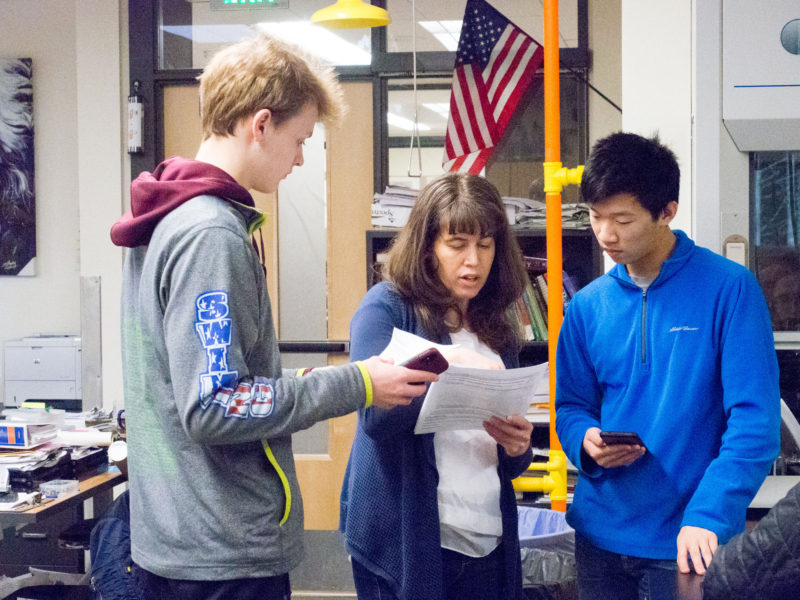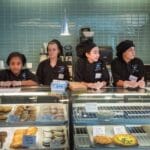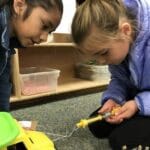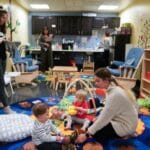Using vocational education to teach academic courses

Kate Allender, of Tesla STEM High School, has designed a course integrating AP Psychology with a hands-on study of forensics.
REDMOND, Wash. — On a recent winter morning at Tesla STEM High School, juniors in Kate Allender’s first-period AP Psychology class are busy preparing for an upcoming unit test, reviewing notes on topics like behaviorism and confirmation bias. It’s not until the second-period bell rings, however, that you begin to see how different this is from a traditional psychology course. Instead of packing up to leave, students migrate over to the room’s pathology lab, well-appointed with microscopes, replicas of human skulls and anatomical models of internal organs. They will spend the second half of this dual-period class examining diseased lung tissues and three-dimensional models of burn victims.
The class combines the academic rigor of AP Psychology with hands-on experience in the field of forensics, the latter as a state-approved career and technical education (CTE) course. In recent decades vocational education has undergone a significant transition: along with its rebranding as CTE, staples like woodshop and auto repair have given way to a new breed of courses aimed at careers in everything from film production to science and engineering. At most high schools, however, the book learning and hands-on experiences are kept separate. Tesla is a rare case in which classes blend a college-oriented curriculum with one aimed at employment. Students say the benefits are obvious.
“AP classes are usually reading a textbook and memorizing a lot of things,” said Christine Lee, a 17-year-old junior. “With forensics, we get to do a lot of lab work, gaining experience and skills that prepare us more for future careers.”
Classmate Sarah Asad agrees. “A lot of stuff we study about behavioral sciences applies to forensics,” said the 16-year-old. “In psychology we learned about pathways to the reward system in the brain which relates to the effects of drug and alcohol abuse we observe in forensics. The lab work really puts things in perspective and makes them easier to understand when we take tests.”
AP classes are usually reading a textbook and memorizing a lot of things. With forensics, we get to do a lot of lab work, gaining experience and skills that prepare us more for future careers.
Christine Lee, a 17-year-old junior at Tesla STEM High School
Allender’s integrated AP/CTE class is part of a unique attempt to provide both the academic foundation and real-world skills education advocates say students will need to thrive in a rapidly evolving career landscape. In AP classes high schoolers are taught a college-level curriculum with the goal of scoring well enough on a year-end standardized test to earn college credit or placement out of freshman introductory courses. AP classes have long been promoted as the most viable path to postsecondary success. Experts, however, say that while these classes have their place, putting such a narrow focus on test-taking comes at a cost.
“When these kids go off to college there have been lots of studies that say they’re not prepared with the communication, critical thinking and collaboration skills they need,” said Denise Pope, a senior lecturer at Stanford’s Graduate School of Education and a co-founder of Challenge Success, a nonprofit education advocacy group. “Learning by doing is more effective in the long term to produce mastery, but that’s not what happens in a traditional AP class.”
“If you really want to … be an attractive employee you need a mix of book learning and real-world experience,” said Russell T. Warne, an associate psychology professor at Utah Valley University who has studied the impact of AP courses on academic achievement. “Kids who want a technical education can benefit from AP and the college-bound kids who already have five AP classes can benefit from the career education. They are not mutually exclusive.”

As part of their AP Psychology course, Tesla STEM juniors Connor Lotzkar, Christine Lee and Sarah Asad have created entries for a regional science and engineering fair.
Adding an effective CTE component to an AP curriculum involves more than just sticking fancy equipment in a classroom, says Allender, who has been teaching for 18 years. “I’ve done the traditional cookie-cutter lab classes,” she said. “The kids didn’t truly understand the scientific method or what goes into a comprehensive research project.”
Now, at Tesla, each of her students is required to participate in an annual regional science and engineering fair, researching and designing a project in consultation with a mentor they must secure on their own time. While Tesla students have enjoyed regular success in these competitions, Allender says that taking home a prize is less important than what her students learn along the way.
“At this point in the year,” she said, “every single one of these kids has hit a roadblock — no mentor feedback, struggling with their design, trying to find lab space. But they learn to persevere and keep trying. They’re building life skills.”
Allender’s class is not the first experience Tesla students have had with an integrated curriculum. “We never looked at AP and CTE as a separate track,” said school principal Cindy Duenas. She notes that students are required to take an integrated AP/CTE course in their freshman and sophomore years, each of them heavily project-oriented. “Our kids have to present their work early and often here. We are educating them to be problem-solvers, innovators, to know how to work in a team.”
Serving a highly educated community with income levels nearly double the national average, Tesla is committed to incorporating career-based programs even though almost 90 percent of its graduates go on to college. That’s a scenario education advocates hope will become more commonplace.
“There’s still a lot of stigma around CTE for both schools and families,” said Gilda Wheeler, program director of Washington STEM, a nonprofit that advocates for equality in STEM education across the state. “ ‘It’s for the poor kids … who aren’t going to succeed in college.’ But giving any kid real-world experience during high school where they’re tackling actual industry challenges gives them access to career pathways, not dead-end jobs.”

Aniya Vega, 17, works with actors during a shoot for her senior honors project at the Academy for Careers in Television and Film high school in Queens, New York.
At the Academy for Careers in Television & Film (ACTvF), a high school in Queens, New York, the integration between CTE and academics reveals itself in a less structured, though equally comprehensive fashion. As sixth period comes to a close, a student crew is busy positioning lights and cameras to film a scene in the school’s weight room. Within a span of about five minutes, numerous problems arise. The track assembled for the dolly is too short. The memory card on the main camera is only showing a few minutes of recording time available even though it has just been erased. No one seems to have the passkey needed to dim the room lights, and the student tasked with operating the boom mic opens the equipment case to find audio hardware he’s not yet learned how to use. “I’m only a junior,” he explains to another student, “and this is senior equipment.”
Moments later, Aniya Vega, a 17-year-old from the Bronx and the director of this senior honors project, enters the room and is immediately besieged with questions about these and other pressing issues. She remains remarkably calm and poised. With a little guidance from a supervising instructor and a teaching assistant, the problems are all addressed, leaving Aniya time to go over the script with her actors before clearing the set for the first take. In a situation that would have caused understandable stress and finger-pointing even among adults, seeing a group of 16- and 17-year-olds stay on-task is impressive. This clearly isn’t their first rodeo.
At ACTvF, officials have found success with a more holistic approach to integrating academic achievement with career training. With a school population that reflects the ethnic and socioeconomic diversity of New York City, ACTvF graduates 98 percent of its seniors (the citywide average is 71 percent), with 88 percent of those graduates continuing on to postsecondary education.
On set, if there’s a problem, I have to use my ingenuity and take whatever information I have to solve that problem. In my life I can do that with any other problem I have.
Marion Valcorza, junior, Academy for Careers in Television and Film high school
The curriculum is centered around film and TV production but also includes a slate of six AP classes. By design, students spend as much of their time involved in production projects as they do in their academic classrooms. For the school, developing skills like communication, collaboration and problem-solving is an ethos that permeates almost every task students encounter.
When 16-year-old junior Marion Valcorza first arrived at the school she found a much different experience than what she was accustomed to. “I was shy and coming from a [middle] school where you get the knowledge, get the work done and that’s all you’re required to do,” she said. “Going into my ninth-grade production class we had to do ice-breakers and learn how to interact with classmates that I’d never met before. It was nerve-wracking.”
Alan Metzger, the school’s director of production, points to Marion’s initial experience as a common one that highlights how uniquely well-suited a CTE-based program can be to give kids skills they need, not just for college or a job, but for life as a successful adult. “There are so many positive attributes you need to have in the production business — being able to take a highly complex idea, break it down into its component parts and execute as a team. Yes, a portion of our students will go into these production careers, but for all of those that don’t, what we teach becomes a platform to learn about how the world works.”
For incoming freshmen, learning how the world works begins by collaborating in small teams of two and three, learning the basics of camera operation and storytelling and using them to create 30-second film projects. As sophomores, they are exposed to more advanced equipment, which they take on location for unsupervised assignments. For their final two years, students select a discipline — like directing, production design, camera or lighting — and work in groups of up to 20 to complete longer-form projects.
Principal Edgar Rodriguez, who was a founding member of the school’s planning team in 2008, acknowledges the difficulties in creating a program from scratch but says that doing so allowed the team to set its own agenda from the start. “We were really committed to designing a school that was open in its admissions to anyone regardless of middle school grades but that had a robust academic program that included AP offerings.”

Tesla STEM High School serves nearly 600 students in Redmond's Lake Washington School District.
With open lines of communication between the academic and production departments, the school finds ways to integrate the two. In an English unit on American theater, for example, students read “A Streetcar Named Desire.” Instead of simply writing an essay about character motivation, students can choose to demonstrate their understanding by designing, staging and shooting a scene from the play.
While acknowledging that not every subject lends itself to this type of integration, Rodriguez is adamant that the key to providing students with scholastic rigor alongside the skills they need to be successful adults requires a very intentional, purposeful effort.
Giving any kid real-world experience during high school where they’re tackling actual industry challenges gives them access to career pathways, not dead-end jobs.
Gilda Wheeler, program director of Washington STEM
“We always have to make sure we are giving the appropriate weight and investment to both CTE and the academics,” he said. Hiring standards for CTE instructors are just as high as those for math and science teachers; the former come with years of high-end professional production experience on their resumés.
Striking a balance between classroom and hands-on learning is an ongoing challenge. It became especially tricky once the school developed an extensive internship program for its seniors at networks and studios in the city’s thriving production industry. “We had to have explicit conversations internally about how to balance kids doing internships and AP classes,” noted Rodriguez, saying that if a student is going to commit to spending one full day per week at an internship, a schedule stacked with three AP classes isn’t realistic.
But getting the balance right pays huge dividends, students say. “Through the years of being here,” said Marion, “I’ve developed better social skills. And the things we learn at school don’t have to be applied only to film. On set, if there’s a problem, I have to use my ingenuity and take whatever information I have to solve that problem. In my life I can do that with any other problem I have.”
Source: HechingerReport
Last Updated on 28 August 2023
We cover inequality and innovation in education with in-depth journalism that uses research, data and stories from classrooms and campuses to show the public how education can be improved and why it matters.





